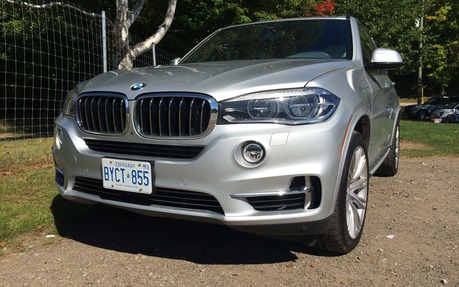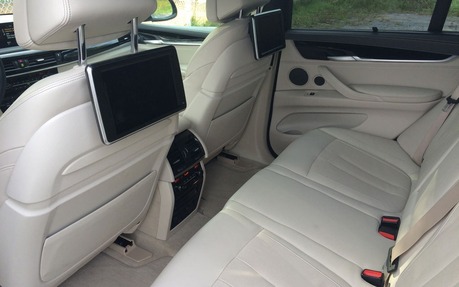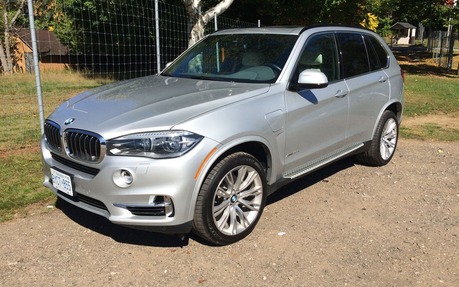2016 BMW X5 xDrive40e: Luxury with a Touch of Green
BMW has been steadily improving their green-vehicle options of late with the release of their all-electric i3 and i8 models. That technology has started to make its way into the rest of the lineup in the form of hybrid electric versions of more popular vehicles such as the X5, and now even the 3 Series.
The BMW X5 xDrive40e is powered by a turbocharged, 2.0-litre four-cylinder engine, an electric motor and a lithium-ion battery. Working in concert, the gasoline engine and electric motor put out 308 horsepower 332 lb.-ft. of torque, enough to propel the SUV from 0-100 km/h in 6.8 seconds. By comparison, the standard X5 with a 3.5-litre gasoline inline-six does it in 6.5 seconds. The power stemming from the two drive units is transformed into forward motion courtesy of an eight-speed automatic transmission and BMW’s xDrive intelligent all-wheel-drive system.
Anyone who has driven an electric car (or even a golf cart) knows that torque is usually in abundance. This allows for quick acceleration from a stop and the X5 40e is no exception. That firm nudge as the increased g-forces press you back into your seat is highly addictive. The neat thing is that this occurs between 0 and 30 km/h, so you’re not breaking any laws or becoming a danger to anyone on the road.

When fully charged, the vehicle is capable of roughly 25 kilometres of emissions-free all-electric motion. This is perfect to scoot around town or in my case, ship the kids to daycare and back twice per day. In theory, I should be able to operate indefinitely on electric power alone if these were the only trips I made during the day. In practice, however, it wasn’t the case. If I needed to hop on the highway to go to the store or something, then the gasoline motor would kick in.
BMW engineers have seamlessly paired these two motors together so that when electric power runs out, a switch to conventional power goes largely unnoticed. There is a small readout in the gauge cluster to indicate if the vehicle is using electric power or not, but the best way to tell is to look at the tachometer to see if the RPMs are at 0 while driving.
There are three drive modes available by way of an eDrive button on the centre console. When the vehicle is first started, the default setting is auto eDrive, with both engine and electric motor working efficiently in tandem. In this mode, the intelligent operating strategy determines the most efficient drive combination at all times and switches to it automatically. The driver can also switch to the all-electric drive mode in which the vehicle is powered solely by the electric motor. Even in this setting, the gas motor will still kick in above 120 km/h.
The third mode that can be activated is the Save Battery setting, which allows the vehicle to conserve or build up the high-voltage battery’s energy reserves for a later point in time. The vehicle can even recharge with regenerative braking, although we’re talking pennies on the dollar here. The only way to gain usable electric power back for driving is to plug the vehicle in again.

On the inside, we find the ample luxury that any X5 provides the occupants. All of the optional extras from the BMW X5 range are available, with the exception of the third row of seats, the Adaptive M Suspension, Active Steering and comfort seats in the rear. The BMW X5 xDrive40e can also be ordered with the coveted M Sport line to obtain a three-spoke steering wheel, an anthracite roof liner, 20-inch wheels, black ceramic-finish controls and paddle shifters.
BMW offers a tailor-made solution for safe and quick battery charging at home, capable of recharging the vehicle in 2 hours and 45 minutes. The charging progress can be checked on a graphic displayed in the vehicle’s instrument cluster or on a smartphone using the BMW Remote app. If you don’t opt for this, you can just plug into any standard 120V outlet in your garage or at work and the battery is recharged in about 7.5 hours.
So how much more is all of this green technology going to set you back? The base 2016 X5 xDrive35i starts at $66,300, and optioned out with the necessary Premium package gets you to $72,800 before freight and taxes. The base 2016 X5 xDrive40e starts at $74,000, which is quite the premium. There are definitely fuel savings to be had and I averaged an excellent 9.5 L/100 km, but I’m not sure it’s enough to justify nearly an $8,000 premium.
Nevertheless, the X5 xDrive40e represents a step in the right direction and with more and more plug-in hybrids coming to the BMW lineup in the coming years, it’ll be interesting to see if they can crowd out the gasoline variants. If you’re in the market for a big luxury SUV, but feel a little guilty about it, then the X5 xDrive40e might just be the thing to add a little touch of green in your life.
| Test drive report | |
| Test model | 2016 BMW X5 |
|---|---|
| Trim level | xDrive 40e |
| Price range | $66,000 – $105,900 |
| Price as tested | CA$74,000 |
| Warranty (basic) | 4 years/80,000 km |
| Warranty (powertrain) | 4 years/80,000 km |
| Fuel economy (city/highway/observed) | 10.2 / 9.4 / 9.5 L/100km |
| Options | N/A |
| Competitive models | Acura MDX, BMW X6, Infiniti QX60, Infiniti QX70, Jaguar F-PACE, Jeep Grand Cherokee, Land Rover Discovery, Lexus RX, Mercedes-Benz GLE, Porsche Cayenne, Volkswagen Touareg, Volvo XC90 |
| Strong points |
|
| Weak points |
|
| Editor's rating | |
| Fuel economy | If they extended the all-electric range, this would improve |
| Comfort | Typical BMW luxury |
| Performance | The base 3.5-litre gasoline engine is still an overall quicker package |
| Infotainment | Rear-seat entertainment system is extremely frustrating to operate |
| Driving | Electric power gives a sense of satisfaction |
| Overall | A great move in the right direction |
